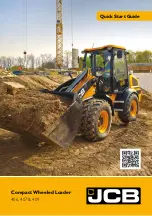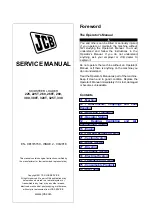
406, 407 & 409
24
25
Please see operator manual for full details.
Routine Maintenance
Electrical System
156
156
9821-9350-5
Fuses and Relays
Introduction
!M
CAUTION
Fuses
Always replace fuses with ones of correct ampere
rating to avoid electrical system damage.
8-3-3-5
The electrical circuits are protected by fuses. Identification
labels are attached to the fuse boxes.
If a fuse blows, find out why and correct the fault before a
new one is installed.
The Primary Fuses (PF) are located in a fuse box mounted
at the side of the battery.
The secondary fuses
B
and relays
A
are located in a fuse
box inside the bay on the right hand side of the cab.
To access the fuses and relays, open the side panel.
K
Access Panels (
T
146)
Unscrew the retaining bolt and remove the fuse cover
panel (not shown) to access the fuses.
K
Fig 104. (
T
156)
P1062300-4A
Fig 104.
B
A
Routine Maintenance
Access Panels
146
146
9821-9350-5
Access Panels
Introduction
T3-100
When placed in their maintenance position, the access
panels give you access to parts or areas of the machine
that are not required during machine operation.
Before you operate the machine, make sure that all of the
access panels are in their operation position and secure.
Engine Cover
Opening the Engine Cover
!M
WARNING
The engine has exposed rotating parts. Switch OFF the
engine before working in the engine compartment. Do
not use the machine with the engine cover open.
5-2-6-5
!M
WARNING
Touching hot surfaces can burn skin. The engine and
machine components will be hot after the unit has
been running. Allow the engine and components to
cool before servicing the unit.
10-1-1-40
Important:
Before you stop the engine, you must allow the
engine to operate at low idle for four minutes. The delay
allows the coolant temperatures to stabilise before you
open the engine cover.
1
Make the machine safe with the loader arm lowered.
Refer to
Prepare the Machine for Maintenance
.
2
Unlock the security lock built into the release button
A
. It is recommended that the cover is kept locked.
3
Press in the release button and allow the gas struts to
raise the cover.
Note:
Your machine may differ slightly from that shown.
Closing the Engine Cover
1
Pull down the engine cover until the latch engages.
2
Make sure the cover is securely latched.
3
Lock the security lock and remove the key.
C012020-2
Fig 96.
A
A
Key lock (ignition key)
Engine cover
Access Covers
Engine Oil
C
A
B
A
Sight glass
B
Hydraulic Oil Filler cap
C
Washer Filler
Hydraulic Oil & Washer Bottle
Routine Maintenance
Engine
163
163
9821-9350-5
Engine
Oil and Filter
Checking the Oil Level
!M
WARNING
Do not exceed the correct level of engine oil in the
sump. If there is too much engine oil, the excess must
be drained to the correct level. An excess of engine oil
could cause the engine speed to increase rapidly
without control.
GEN-1-18
Note:
The engine must be level when you check the oil
level to make sure the measurement is correct.
1
Make the machine safe. Refer to
Prepare the
Machine for Maintenance
.
Note:
Wait at least 15 minutes after the engine is stopped
before you check the oil level. This gives time for the oil to
drain into the oil pan.
2
Open the engine cover. Refer to
Access Panels,
Engine Cover
.
3
Remove the dipstick
A
and clean the dipstick.
4
Replace the dipstick and remove it again. Make sure
that the oil level is between the two marks on the
dipstick.
Note:
Never operate the engine with the oil level below the
low mark or above the high mark. Poor engine
performance or damage can occur.
5
If necessary, to add the engine oil:
a
Remove the filler cap
B
.
b
Add the recommended oil through the filler point
until its at the correct level on the dipstick.
6
Replace the dipstick. Repeat steps 3 to 5 as required.
7
Attach the filler cap and make sure its secure.
8
Close and 'latch' the engine cover.
B
A
Fig 24
Fig 29
Fig 26
Fig 25
Fig 28
Fig 27
A
Engine Oil Dipstick
B
Engine Oil Filler
A
Filler
A
Relays
B
Secondary
Fuses
A
Air Filter
B
Fuel Filter
Routine Maintenance
Engine
167
167
9821-9350-5
Air Filter
Cleaning the Air Filter Dust Valve (406 Machines)
Important:
Do not run the engine with the dust valve
M
removed.
K
Fig 117. (
T
167)
.
1
Make the machine safe with the loader arm lowered.
Refer to
Prepare the Machine for Maintenance
.
2
Open the engine cover.
3
Check the dust valve
M
is not blocked.
4
Inspect the rubber flaps for cuts and nicks and check
that the rubber is not perished. Renew if necessary.
5
Close the engine cover.
332260-5A
Cleaning the Air Filter Dust Valve (407 & 409
Machines)
Important:
Do not run the engine with the dust valve
K
removed.
K
Fig 117. (
T
167)
.
1
Make the machine safe with the loader arm lowered.
Refer to
Prepare the Machine for Maintenance
.
2
Open the engine cover.
3
Check the dust valve
K
is not blocked.
4
Inspect the rubber flaps for cuts and nicks and check
that the rubber is not perished. Renew if necessary.
5
Make sure that the air holes
L
are clear.
6
Close the engine cover.
332260-5B
Fig 117. 407 & 409
L
K
A
B
Routine Maintenance
Engine
165
165
9821-9350-5
Cooling System
Checking the Coolant Level
Visually check the coolant level daily.
Check the quality of the antifreeze mixture every year -
before the cold weather starts. Change it every two years.
!M
WARNING
The cooling system is pressurised when the coolant is
hot. When you remove the cap, hot coolant can spray
out and burn you. Make sure that the engine is cool
before you work on the cooling system.
9-3-3-1_2
1
Get access to the engine. Refer to
Access Panels,
Engine Cover
.
2
The coolant level should be between the
MIN
and the
MAX
marks on coolant reservoir.
Note:
If the level in the expansion bottle is low, then
continue with steps 3 to 4.
3
Carefully loosen cap
A
on the coolant reservoir. Let
any pressure escape before removing the cap. Fill
with pre-mixed water/antifreeze until it reaches the
correct level.
Note:
To prevent air becoming trapped in the cooling
system, do not exceed the maximum fill-rate shown. Refer
to
Fluids, Lubricants and Capacities
.
4
Run the engine for a while to raise the coolant to
working temperature and pressure. Stop the engine
and checks for leaks.
T070350-33
Fig 114.
MAX
MIN
HOT
COLD
A
Coolant
Secondary Fuses
and relays location
Routine Maintenance
Electrical System
156
156
9821-9350-5
Fuses and Relays
Introduction
!M
CAUTION
Fuses
Always replace fuses with ones of correct ampere
rating to avoid electrical system damage.
8-3-3-5
The electrical circuits are protected by fuses. Identification
labels are attached to the fuse boxes.
If a fuse blows, find out why and correct the fault before a
new one is installed.
The Primary Fuses (PF) are located in a fuse box mounted
at the side of the battery.
The secondary fuses
B
and relays
A
are located in a fuse
box inside the bay on the right hand side of the cab.
To access the fuses and relays, open the side panel.
K
Access Panels (
T
146)
Unscrew the retaining bolt and remove the fuse cover
panel (not shown) to access the fuses.
K
Fig 104. (
T
156)
P1062300-4A
Fig 104.
B
A
Fig
29
Fig
26
Fig
27
Fig
28
























